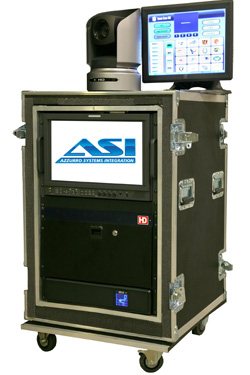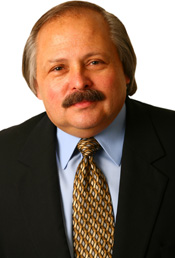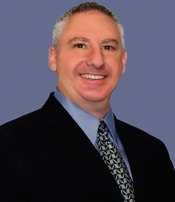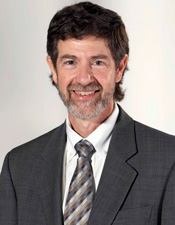System Integrators Focus on File-based Workflows
LAS VEGAS—While stereo 3D and Mobile DTV are hot buzzwords for this year’s NAB Show, system integrators say that products for creating cost-efficient file-based workflows is their top priority. Without a robust, automated file-based workflow, broadcasters can’t easily repurpose media content that’s compliant with every diverse target medium including home distribution, PC/IP-based viewing, and mobile devices.

At NAB, Azzurro will demo its AzzurroCam robotic production system, which enables customers to have fully automated control of production equipment at remote sites so broadcast quality video can be transmitted live via IP. “Broadcasters are investing heavily to create the highest quality programming for 3DTVs and HDTVs, and then they need to repurpose that content to display properly on the four or seven inch screen of a portable device. That’s the workflow dilemma right now,” said Marc Bressack, executive vice president at Azzurro Systems Integration in Northvale, N.J. “Since broadcasters want to create more competitive programming and serve new markets with fewer operators, they need workflow and automation solutions that make their staffs more productive. We develop our own technology where we see the right opportunity to improve the workflow.”
PROACTIVE APPROACH
Azzurro will demonstrate its own workflow solutions in booth N1331 including AzzurroCam, a robotic production system that enables customers, such as CNBC, DirecTV, and the NFL, to have fully automated control of production equipment at remote sites including cameras, microphones, and lights so broadcast quality video can be transmitted live via IP.
The Azzurro team consists of experienced personnel formerly with A.F. Associates and Ascent Media. Today they have numerous ongoing projects, including a recent upgrade to the Turner Sports’ facility for March Madness; renovating the NOC for Scripps Network in Knoxville; as well as building new broadcast facilities for Origin Digital, a content distribution network with Internet rights to major sports events.
“For file-based workflows, it’s particularly taxing to move stereo 3D and the proliferation of audio channels now becoming commonplace with HD video,” said Joseph Policastro, senior director of Broadcast Integration Services (BIS), in Union, N.J. “The left eye/right eye streams of stereo 3D mean that your 40-input switcher can now only bring in 20 sources, and your server’s storage capacity is also essentially cut in half. If you maintain your production standards, stereo 3D is very costly to push through the plant.” Policastro added that manufacturers do not yet offer all the components necessary to disperse stereo 3D HD throughout the production workflow.
With respect to audio, the push for Surround Sound means 12 audio channels or more—including surround, stereo, and mono mixes—have to follow the HD video throughout the entire workflow. At MTV, BIS installed one of the first hybrid routers as an alternative solution to the traditional method of distributing multiple audio channels throughout the facility.
Policastro said, “The newer routers have more sophisticated ways to process embedded audio data, MADI, and 3G/s HD all within the same architecture. This allows us to exploit the benefits of 64 channel MADI streams via a fiber interface to interconnect the audio consoles, intercom and media storage devices without requiring all the outboard equipment and cabling you normally would have to deploy.”
LOOKING FOR ROI
Mark Siegel, president of Advanced Broadcast Solutions, in Seattle, agrees that file-based workflows—as well as signal compression and mitigating the heavy lifting of transcoding—are still pressing issues for the industry. Many broadcasters are still trying to overcome obstacles or fill gaps to build out their end-to-end file-based workflows.

Marc Bressack, executive vice president, Azzurro Systems Integration

Mark Siegel, president, Advanced Broadcast Solutions

Dave Van Hoy, president, Advanced Systems Group
“Once the media is in the file-based workflow, it’s easier for broadcasters to repurpose it for different distribution methods,” said Siegel. “The half-hour newscast has to be repackaged into small one to three minute highlights for viewing on mobile devices, so having a workflow that supports multiplatform distribution is critical.”
Siegel said they know where the industry is going long before the show because manufacturers visit them a year in advance to get their input and discuss their product plans. They also feel it’s important to keep their customers fully informed about new trends in technology, and for this reason, ABS is the Gold Sponsor of the 2011 NAB Engineering Conference.
“As a systems integrator, we look beyond the technology to show broadcasters innovative ways to use their available resources and new capital investments to maximize their return on investment,” he said.
Advanced Systems Group (ASG), in Emeryville, Calif., will go to NAB in search of file-based workflow solutions, including digital asset management and archival tools. Dave Van Hoy, ASG president said, “We’ll also attend the Stereo 3D Summit because stereo 3D is of great interest to all our clients, especially those working on 3D cinematic releases and corporations using stereo 3D for scientific or medical applications.”
Phil Whitebloom, vice president of sales and marketing Communications Engineering Inc. (CEI) in Newington, Va. said, “File-based workflows and automation products will be of great interest at NAB because they still present many technical challenges. There is no single solution out there that fits every customer’s unique requirements.
“Since a file-based workflow encompasses many tasks, including ingest, media asset management, editing, automation, and delivery systems, it’s not something you can give a quick price on,” he added. “While file-based workflow systems are marketed as complete, end-to-end solutions, this may not always hold true in all situations. File-based solutions can be very diverse. You really need to understand the specific technical and business needs of the client in order to design the most appropriate solution."
Get the TV Tech Newsletter
The professional video industry's #1 source for news, trends and product and tech information. Sign up below.

